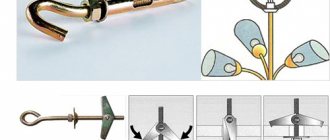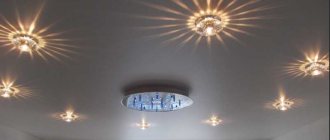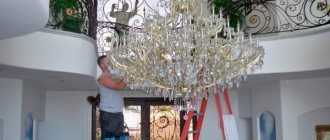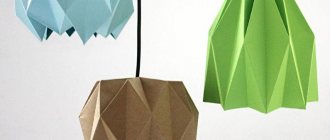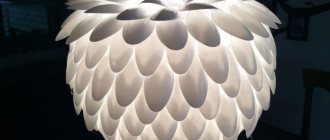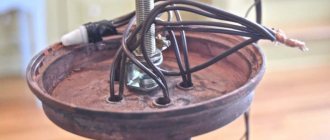As a rule, indoor renovation ends with the installation of lighting fixtures on the ceiling. Despite the fact that tension systems and plasterboard suspended structures have now become widely popular, the traditional finishing method - puttying the ceiling base and then painting it - still does not go out of fashion. Therefore, the question of how to hang a chandelier on a concrete ceiling is relevant for those who have decided to carry out the installation work to install the devices themselves.
Basic methods
First, let's figure out what options there are for installation on the ceiling. Today there are two types of fasteners:
- Hook - used for old-style chandeliers, as well as very heavy lamps
- A mounting strip or bracket is a modern fastener that is used for light chandeliers and lamps
The specified types of fastening involve working with a concrete slab. Therefore, you cannot do without special tools. Next - details on how to attach a chandelier using the above methods.
Features of installing spots in a suspended ceiling
Installing an overhead ceiling spot in a suspended ceiling
The tools that will be required to secure ceiling light fixtures depend primarily on what material the ceiling sheet itself will be assembled from. If the suspended covering is wooden or plasterboard, purchase special core bits with a centered drill bit and a drill. However, holes in soft drywall can be easily cut with a jigsaw or hacksaw.
For slatted and frame ceilings, you will definitely need scissors for working with metal and thin files for metal surfaces.
Installation holes for overhead lamps are always cut after the ceilings are installed, but before the finishing coating is applied to their surface. This method allows you not to touch the ceiling frame. In order to avoid mistakes when cutting holes, it is important to draw in advance a drawing plan for the location of the lamps along the ceiling panel.
Accuracy will also be required in the size of the hole itself. The lighting equipment should fit tightly onto it, covering it from the outside, and the necessary wires should fit inside without interference. Holes for overhead lamps are always made smaller than the size of the device itself, in contrast to built-in lighting, where it must correspond exactly to the size of the lamp.
Hook mount for chandelier
A more difficult task is installing a chandelier on concrete ceilings on special hooks. To begin with, let’s make a reservation that the hooks are as follows:
- With regular thread
- With anchor bolt
A threaded hook is used for mounting lightweight chandeliers (3-4 kilograms) - only in this case can the fastener cope well with the task. For heavy lamps weighing more than five kilograms, hooks on anchor bolts are used.
Safety precautions when working
During the installation of the chandelier, it is important to follow safety precautions to avoid electric shock. Therefore, before installing the lamp, the room is de-energized. To do this, open the switchboard and lower the switch. Check the lights are turned off and the voltage in the electrical wires using an indicator screwdriver. If you fix the fasteners incorrectly, this will damage the power supply.
Another safety measure when installing a lamp is a mandatory check of the grounding of the electrical wiring.
Return to contents
Some useful tips for hanging any chandelier on a concrete ceiling
Our tips will help you quickly and efficiently install a chandelier on a concrete base:
Kawabanga! Shotcreting of concrete
— If you need to hang a heavy chandelier, you should use anchor fastening. It is also best not to do the work yourself, but to use the help of a partner
— When installing a chandelier anchor hook, it is recommended to carefully match its diameter with the diameter of the hole so that it can be screwed tightly
— Use special electric screwdrivers to install the chandelier, which will signal if current is supplied through the wire. This will simplify and speed up your work and protect you from surprises when installing the chandelier
What tools are needed?
To attach a light source to a concrete ceiling, you need to prepare the following tools:
- Screwdriver Set;
- electric drill;
- a set of drills for working on concrete;
- pliers, wire cutters;
- electric screwdriver;
- current indicator;
- elements for fastening products;
- wire connection terminals;
- stepladder.
The method of fixing the chandelier determines the selected type of electrical appliance.
Types and methods of fastening
When choosing your lamp, even in the store you need to pay attention to the mounting methods.
Modern ceiling lighting fixtures are available with several types of chandelier mounting options:
- a loop on the luminaire fixture that allows it to be installed on a ceiling hook. This is one of the main types of mounting a ceiling chandelier. In this case, the base should be as strong as possible, for example, concrete floors.
- a reliable I-beam platform for mounting a massive, heavy chandelier. Allows fastening at several points.
Having considered the types and methods of fastening, you can decide how to install the chandelier on the ceiling correctly, without unnecessary and unpleasant consequences.
Where can ceiling spots be used?
Spot spots in the interior design of the living room
Spot spots are an ideal option for rooms with a small area, because they will not only completely illuminate the entire space, but also make it visually larger and wider. Spot ceiling lights are perfect for installation in corridors and bathrooms - rooms where bright and directional light is needed.
Since spots do not necessarily come in the ceiling variety, they are also widely used to illuminate technical and specialized spaces - swimming pools, store windows, staircases. Spots are also used in the arrangement of street lighting.
Installation using a mounting strip
Before attaching the chandelier to the ceiling using a mounting strip, it must be:
- Markings are made for fastening the strip. To do this, the plank is applied to the ceiling and outlined with a pencil so that the attached elements do not interfere with the connection to the electrical network. Mark the drilling locations. Plastic dowels are carefully driven into the drilled holes. The plastic should be ribbed, which will prevent it from becoming loose over time and starting to fall out of the nest;
- Using screws or self-tapping screws, the fastening strip is attached to the ceiling.
- After installing the connecting wires, the bowl or other decorative element is applied to the installed bar, aligning the connecting holes.
- Tighten the entire structure with decorative nuts, after which you can screw in the light bulbs and install shades or other components of the lamp.
It is worth noting that hanging a chandelier from the ceiling can be difficult alone. Another hand is needed to connect the wires. Therefore, when connecting a lamp to the mains, one person holds the chandelier, the other handles the wires.
You can mount a chandelier on the ceiling with your own hands without any problems, the main thing is to prepare the necessary material and tools, study the included connection instructions and always have an assistant.
Wiring connection
To connect electrical wiring, first turn off the voltage at the input panel.
Then follow these steps:
- determine the power supply system - three-wire or two-wire;
- then mark the separation of the wires at the place where the chandelier is connected to the wiring, the phase wires should have red, brown or black insulation, and the neutral wires should have blue or light blue;
- connect the phase and neutral conductors to the corresponding terminals of the chandelier; if the wiring also has a grounding conductor, connect it to the lamp body;
- if the chandelier has several lighting circuits or each LED lamp has a separate pair of terminals, then the sockets are connected to the wiring through special clamps.
After connecting to the wiring, the lamps are covered with a lamp cap, and decorative elements are installed. If the design of the chandelier includes a decorative cup near the ceiling, then it is also put in place.
Types and methods of mounting chandeliers: features, advantages and disadvantages
To attach the lamp, make a hole in the base, insert a dowel, and then screw the hook into it.
Kawabanga! How to fix a wooden pole on concrete: concreting the pole and mounting it on the base
Butterfly hook
The butterfly dowel consists of a self-tapping screw and plastic “wings”. After twisting, the clip of the product opens and rests against the back of the base. And thanks to the ribbed sections, the dowel does not scroll or fold inside.
Its design allows the load to be evenly distributed. This element is suitable for drywall and plastic.
However, a butterfly hook is rarely used, since it can hold products no heavier than 3 kg.
Make a tunnel in the drywall or plastic panel. Screw the dowel into the cage, turning it several times. Then insert the hook and tighten.
Bar for mounting a chandelier
Mounting to a strip is a neater installation method because the light fits tightly to the ceiling, so the wires are not visible.
However, the bar for attaching the chandelier is suitable for products no heavier than 2 - 3 kg. In addition, the installation process is more complex than in the case of a hook.
Installation of the lamp on the bar occurs according to the following plan:
- There are 2 holes made in the base into which dowels are inserted and screws are screwed in.
- The lamp body is fixed to the bar with nuts.
For mounting heavy lighting devices, a cross-shaped bar is used. It is installed in the same way as a regular one, however, its installation requires a larger base, in addition, it has more attachment points.
Threaded hanger
This type of fastener is used for concrete floor slabs. If the lamp needs to be attached to a plasterboard or PVC ceiling, then before installing them you need to prepare a platform on the old ceiling, which will ensure the rigidity of the structure.
To secure the lamp, insert the spring-loaded petals into the hole, after which they will open inside the base. Using the threaded connection, adjust the height and fix the product body.
Anchor suspension
This is a large anchor-shaped hook with a spacer that expands inside the ceiling. The anchor can withstand heavy loads and provides reliable fastening to a concrete base.
However, the hook does not look aesthetically pleasing, so it is suitable for lamps with a decorative trim.
To install an anchor suspension, drill a hole of the required diameter, insert the anchor with the hook until it stops (hammer if necessary), make 3 - 5 turns.
Collet mount
The collet provides a rigid and durable fixation. This is a brass pin with a spacer along one edge. It is suitable for plasterboard and tension coverings. Collets for light and heavy products are available for sale.
To install a chandelier on a collet, you need to prepare a mortgage in advance.
To attach the collet, drill a tunnel in the platform, drive the collet, and tighten the pin.
Kawabanga! Concreting pillars for corrugated fence
Screw with half ring
It is enough to simply screw in the screw with or without preliminary drilling (depending on the diameter of the element and the base material).
However, the hook screw is only suitable for light chandeliers.
Phasing
If there are no color markings on the wires, you will need an electrical device to recognize them. It is called a phase indicator and shows its presence at the end of the wire. It has an external resemblance to a screwdriver.
Such a device consists of several parts, which are:
- housing made of insulating material;
- metal conductive tip;
- depending on the model, electronic display or signal LED;
- button or metal terminal.
Using an indicator screwdriver, the presence of voltage is determined as follows: it is held with the right hand between the thumb and middle finger, and the index finger is placed on the metal terminal.
You need to touch all the wires one by one with the sting. When contact with the phase wire with voltage is made, the corresponding icon will appear on the display or the LED will light up. Phase search using an indicator is performed exclusively with one hand.
Do not touch the indicator screwdriver or the wire insulation with your other hand. The fact is that in the event of an insulation breakdown, an electric shock occurs, and when it passes from one arm to the other, there is a high probability of a sudden contraction of the heart muscle.
Phasing is done step by step:
- First of all, they de-energize the room, for which it is enough to unscrew the plugs or turn off the machine in the panel. In addition, turn off the switch going to the lamp. The old device is removed, and if this was done earlier and its ends are already insulated, freed from the insulating tape. Using an indicator screwdriver, make sure there is no phase on each wire one by one. If necessary, strip the insulation so as to free approximately one centimeter of the metal core. The wires should be spread apart - they should not touch each other.
- Turn on the machine on the panel, as well as the lamp switch. An indicator screwdriver is used to touch the exposed part of the wires to determine the phase and neutral wire. To make it convenient, mark the neutral conductor with a marker, a piece of electrical tape, or bend it. When three wires are brought out of the ceiling, and there is a two-key switch on the wall, first of all, turn on both keys, find the neutral and two phase wires and mark them. Then one of the keys is turned off to see that there is no phase on one wire. Next, turn off the second key to make sure there is no voltage on the other wire. In this case, you can connect the chandelier according to a two-stage diagram. If there is no indicator, use a multimeter instead, for which it is switched to the AC voltage measurement mode.
- At the next stage, they are looking for the place where the wiring is laid in the ceiling. This is done so as not to damage the wires when the strip for placing the chandelier is attached. For a non-contact method of determining the phase, an electronic indicator will be required. They hold it in their hand, turn on the switch and begin to move it at a short distance from the ceiling in the place where the plank is planned to be attached. When a phase wire is found, a phase sign will appear on the display. The device is carried back and forth several times, marking the boundaries where it detects the phase. As a result, the location of the cable is determined, which means the place where you should not drill. Turn off the switch and machine. Then they begin the next stage of preparation.
What and how to attach to a plasterboard sheet
The ceiling chandelier is attached to the gypsum board using anchors or collet pins, which are used for the heaviest products. Such fasteners must be fixed to the base ceiling. A threaded hook and spring dowel are used for lighter models.
Required materials and tools
To mount a chandelier on a gypsum board, you need to prepare a hammer drill, screwdrivers, wrenches, and a hammer. In addition, you will need pliers, electrical tape, terminal blocks, a knife, a stepladder, and selected fasteners.
Instructions for installing the lamp on a plasterboard ceiling
If you bought a heavy lighting structure, then attach it to an anchor suspension:
- Drill a hole (30 - 60 mm) in the gypsum board.
- Make a hole in the base for the hook, taking into account its diameter.
- Loosen the nut a little, pull out the stud, and insert the fastener.
- Tighten the nut.
If necessary, this mount can be extended using a metal rod.
The lamp is installed using the same principle using a threaded hook and a spring dowel.
A lightweight lamp (up to 3 kg) is mounted on plasterboard, reinforced with a profile frame:
The profile frame relieves the load on the plasterboard ceiling.
Options depending on the type of room
The layout of light sources on the ceiling can be very diverse. From placing a large number of lamps around the perimeter of the room to cross-shaped LED strips, from the edges converging to the center of the ceiling.
Corridor
How to properly light a corridor:
- The basic rule is the competent use of light fluxes. In the corridor, it is best to direct the light sources towards the walls or up towards the ceiling. This will visually enlarge the room.
- When choosing lamps, it is better to choose halogen products, since it has been proven that halogen lamps help increase the height of the corridor.
- The interior design in the corridor will also be helped by increasing the width of the walls. In this case, it is best to mount the lamps on the walls - this will create a feeling of volumetric space.
Classic lighting in the corridor
Some owners of apartments or houses are content with LED strips on the ceiling in the corridor, the light of which is quite enough to move further into the room.
Kitchen
There are 2 kitchen areas: the main one (a place for cooking) and an additional one (a dining room). And if the dining room should be equipped with uniform lighting, then the place where food is prepared requires additional lighting or fairly bright light sources. Wall sconces are a good solution, but spotlights are more often used.
Basic and additional lighting in the kitchen
Bedroom
Dim or dimmable light is an ideal solution for the bedroom. In the bedroom, it is best to make 2 light sources: the main one - for good illumination of the bed and lighting as in decorative lighting. In the latter case, an LED strip hidden behind a specially mounted niche will work well. And as the main light for the bedroom, wall lamps or small neon lamps near the ceiling cornices are often used.
Many owners of apartments and houses prefer not to complicate the electrical wiring, but simply install one chandelier in the center of the room with the ability to adjust the intensity of the light flux. This device is called a dimmer.
Chandelier above the bed in the bedroom
Living room
Firstly, all types of glossy ceilings are relevant for living rooms, which reflect a directed light flux, thus spreading light throughout the entire area of the room. And for such an interior, one large chandelier with simple incandescent lamps is quite enough. But still, the picture remains a little unfinished and lighting is added around the perimeter of the ceiling.
Chandelier and spotlights in the living room
For multi-level ceilings, there is much more free space where lighting sources can be placed. The first level is the main light, made using spotlights, and the second is LED lighting, or several neon strips.
Bathroom
The bathroom does not require any special research or interesting solutions; the place near the washbasin, where the mirror most often hangs, should be illuminated, and one light source in the center of the room is sufficient. A flat chandelier with a matte shade, which will slightly muffle the light flux, is quite suitable.
Wall sconces in the bathroom
In the bathroom, much more attention should be paid to the safety of electrical wiring and all sockets and switches should be properly sealed from moisture penetration.
Balcony
Diversity in interior styles often requires converting the balcony into an additional seating area or office. Both in the first option and in the second, the balcony must have high-quality lighting, which requires the use of reliable lighting devices, which include:
- Built-in wall sconces.
- Ceiling spotlights.
- Tabletop portable light sources.
Balcony as a separate room
Modern design provides several options for lighting the balcony. For example, 2-3 pendant lamps on the ceiling and several wall LED light sources. The power of the light bulb is selected based on the luminous flux required for high-quality lighting of the room.
Electrical wiring: how to avoid getting tangled in wires
The wires are connected according to the instructions that come with the lamp. However, problems often arise at this stage.
Wiring phasing
When checking phasing, you only need to work with one hand; holding the wire even by an insulated section is strictly prohibited! This poses a risk of electric shock. For the same reason, you should not touch the tip of the tester during operation.
It is recommended to carry out phasing while standing on a rubber mat.
To check that the wires are connected correctly, turn off the light at the switch (there is no need to turn off the circuit breaker). Touch the tester tip to the phase conductor; if everything is correct, the light bulb will not light up.
Calling
If you don’t know exactly how the wires run, and you need to make a hole to mount the lamp, then you need to carry out a test. Otherwise, you may damage the cable.
To find the wires, follow this plan:
Then disassemble the structure and begin installation work.
Installation of lighting fixtures on a cross-shaped strip
This method is used when there is a need to attach a heavy chandelier to a suspended ceiling, which requires the creation of additional support. It has much in common with the previous version of mounting lamps.
A cross-shaped strip is used as a fastener for massive lighting devices with a wide base. It is impossible to mount it in a suspended ceiling structure within the mounting holes, since they are located at a great distance from each other.
For this reason, a supporting platform or wooden base is attached to the ceiling. Such an element can be made from a plywood sheet with a thickness of 10 -12 millimeters; it must correspond to the parameters of the cross.
The suspended ceiling is equipped with 5 holes, reinforced with thermal rings. One of them, intended for electrical wiring, is made large. The remaining four are created small and used to connect the power supply - they must match the mounting holes on the cross-shaped strip.
By the way, it is prohibited to connect wires made of different metals. For example, copper wires can only be twisted with copper wires, otherwise a short circuit cannot be avoided.



